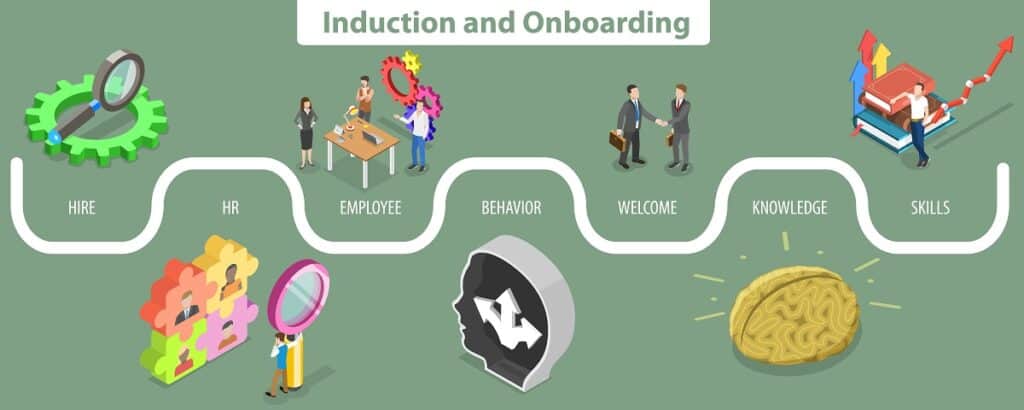
Induction is critical to how new employee feels about their new workplace. In fact, a recent multi-year project on factors affecting retention completed by Response Research revealed that the quality of the onboarding (induction) process showed a direct correlation to retention.
Ask anyone in charge of inducting new employees, and they will likely tell you how much is involved in doing it right. This comes at a cost. Implementing aspects of eLearning into your Induction program can dramatically reduce costs, ensure consistency of the experience, increase engagement and provide auditable records of completion.
Benefits of using eLearning in the Induction Process
The advantages include, but are not limited to, the following:
- More time is freed up for those employees conducting induction
- Increased flexibility for both time and location
- Improved knowledge transfer as a range of media can be used
- Consistency in the induction experience
- Improved cost-efficiency in the training process
- Provide auditable results of completion and comprehension
More Time is freed up for those conducting the induction
Managers, Team Leaders, and Supervisors often take part in or lead a new employee Induction Program. Depending on the company, inductions are highly structured or are more adhoc. Taking part in the delivery of induction training means that key staff members are taking time away from other work, which causes a flow on impact, especially when the process is unplanned and adhoc.
Building part of the induction program online means that information can be communicated to the new employee via an online portal. This can even happen before they arrive on site. For example, key safety information, including site safety, can be designed and delivered in a way that makes it possible for a new hire to get across the key aspects of safety before they set foot at your premises. This reduces the time needed to complete site safety induction as the facilitator can check that the employee has already accessed and completed training prior to arrival.
Of course, this is just one example of time being freed up. Initially, it’s one step back to take two steps forward, as the information conveyed during induction needs to be documented and converted into an online version. This does require an investment, however, there are ways to make this process streamlined and efficient. At Optivly, we leverage a range of tech tools, both hardware, and software, to speed up the process of capturing information and converting it into engaging online experiences.

Training Flexibility
The always-on and always-available nature of eLearning means that new employees do not have to wait for an official induction program to start. It is not uncommon for new employees starting in a role who have to wait three months for the next induction. In fact, it is also possible for employees to have worked for six months or longer if they happened to be absent when the induction was run.
With the aforementioned in mind, it makes good business sense then to ensure that employees are given the right information delivered in a consistent, accurate, and timely way, ensuring that the company is meeting all of its statutory obligations. We would suggest that the best practice is to design a blended delivery program where parts of the induction are delivered in person at the location and part is made available online. This design also breaks up the day during an onboarding experience as a new hire can take part in a physical exercise and then switch to acquiring some of the required knowledge via a phone, tablet, or computer upon completion.
Improved Knowledge Transfer
One key advantage of adding eLearning elements to your induction is that it allows employers who hire new employees that don’t necessarily have English as a first language to overlay translations to improve the knowledge transfer and increase understanding and comprehension. Aside from language challenges, the other benefit of eLearning is that it allows the use of multi-media elements that have been shown to increase engagement and knowledge retention.
This is the ‘Youtube era’ – 60% of online media consumption is video. One of our go-to mechanisms is to use a blend of live-action footage interspersed with animations that allow us to rapidly create workplace specifically contextualised learning experiences that employees relate to. When you add quiz questions to these video-based learning objects, you have confirmed that an employee has understood the subject matter.
Consistency
With in-person training sessions, supervisors and trainers are often assigned to complete various parts of the induction. This leads to discrepancies and inconsistencies in the information conveyed to new employees. Important information may not be communicated at all, or it may be communicated incorrectly, leaving the organisation open to risk.
Employers can ensure that all training is consistent with a structured, designed eLearning induction process. The information can be checked for validity, currency, and accuracy before it is transferred into an online experience. If designed correctly, the online program can easily be updated as information changes.
Cost Efficiency
By transferring part of the induction process online, employers can reduce the time taken for induction, decrease the time it takes to bring new employees up to speed, and reduce the time and cost implications of having managers, supervisors, and trainers conducting entire programs in person.
The always-on, always-available nature of online means that a new hire can access induction information immediately upon commencing work or even prior to day one. This pushes part of the cost of the induction to the new employee before they are on the payroll. There is a benefit to the new employee though, in doing this as they are able to get familiar with their new environment and the systems they will use before they start. This reduces ‘new starter anxiety’ and improves their initial impression of the company they have joined.
What is typically included in an online job induction?
Online job induction involves training and orientation for the new employee. Typical components can include:
- Helping new employees understand their role and how it fits into the organisation;
- Introduce company processes and (workplace health and safety) policies and procedures;
- Provide site-safety information;
- Information on the company values and behavioural expectations;
- Information on products and services the business provides;
- The overall structure of the business and some of its key goals and ambitions over the next 2 -3 years.
- Introduction to key systems and how to use them – e.g., company intranet/portal.
Assessments and quizzes can be integrated into the online induction process to confirm the new employee’s understanding of what they have just learned.
How do you conduct an online induction?
The best practice is to assign someone to guide the new employee through the entire process. A single and consistent point of contact that provides assistance where they can and guides them to where they need to go to get help for specialist information. This also includes helping the employee log in and engage with the learning material’s online component.
The theme of best practice is to ensure the new hire has an induction schedule that breaks down what they will be learning, where the learning will take place, and where to do it for assistance. The employee’s progress through the induction program should be monitored, and their feedback on all aspects of the induction experience should be gathered to ensure continual improvement and that the content – especially the online content – remains current and factual.
Typically the online component of the induction process would be housed in a Learning Management System, which is ideally linked to the company’s HR system. Completion of courses and learning experiences can then be automatically updated on the HR system against the employee’s record. This is especially useful for ensuring that any mandatory or legislated activities are completed and the result stored for future reference.

What is virtual induction for new employees? (Why is it different from online?)
Virtual induction for new employees may sound the same as online induction, but where it differs is due to the immediacy and live nature of the training. Virtual training is similar to on-site training, except you won’t be in the same room as your trainees, and it is conducted via Zoom or Teams or a similar web conferencing platform.
Virtual induction allows employers to save money and time while managing the induction process more closely and ensuring there is still a human and personal element to the induction. This is especially useful where companies are geographically dispersed and its economically or logistically not possible to provide in-person inductions.
Final Thoughts
Online or blended (as we recommend) induction provides numerous benefits to both the employer and the employee. More time is freed up for those employees conducting induction, there is increased flexibility for both time and location for the employee to undertake the necessary training. There is improved knowledge transfer based on the range of interactive and engaging multimedia that can be included in the design. A consistent induction experience is delivered to all employees going through the program, and the complete results provide auditable data.
You only get one chance to make a good first impression. Maybe it’s time to analyse what first impression you are creating for your new employees.
References
https://blog.acolad.com/how-to-use-elearning-for-induction-training
